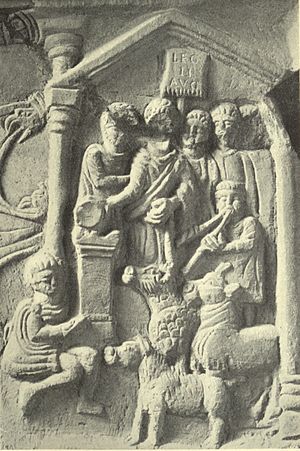Bridgeness Slab facts for kids
The Bridgeness Slab is a special stone carving from ancient Rome. It was made around 142 CE, which is a very long time ago! This slab helped mark a part of the Antonine Wall. The Second Roman Legion built this wall. Many people think it's the most detailed and best-kept Roman stone found in Scotland. This sandstone tablet was discovered in 1868 in a place called Bridgeness, near Bo'ness in Scotland. You can see the original slab at the National Museum of Scotland in Edinburgh. There's also a copy of it close to where it was first found.
Contents
What is the Bridgeness Slab?
The Bridgeness Slab is a "distance slab." This means it's a stone that shows how much of the Antonine Wall a Roman legion had built. It's like a giant sign saying, "We built this much!"
How was the Bridgeness Slab found?
The slab was put up in 142 CE. This was to celebrate finishing a part of the Antonine Wall. It was found in 1868 when people were digging on land owned by Henry Mowbray Cadell. His son, Dr Henry Cadell, actually saw it being discovered!
Mr. Cadell gave the slab to the Society of Antiquaries of Scotland. They put it on display in the National Museum of Scotland in Edinburgh. But first, they had to make a copy for the local people to see.
Are there copies of the Bridgeness Slab?
Yes, there are a few copies! The first copy only showed the middle part of the original slab.
A newer, better copy was revealed in 2012. This one includes the side pictures too. It was made using a special digital laser scanning method. This was safer than using molds, which could have hurt the old stone. You can find this copy in Kinningars Park in Bridgeness.
What does the Bridgeness Slab show?
The Bridgeness Slab has a message carved in the middle. It also has cool pictures on its sides.
The Latin Message
The writing in the middle is in Latin. It says: "Imp CaesTito Aelio / Hadri Antonino Aug Pio p p legII Aug / per m p ĪĪĪĪ DCLII / FEC".
In English, this means: "For the Emperor Caesar Titus Aelius Hadrianus Antoninus Augustus Pius, Father of his Country, the Second Augustan Legion completed [the Wall] over a distance of 4652 paces."
A Roman pace was about 5 feet. So, 4652 paces is a long way!
The Left Side Picture
On the left side of the slab, you can see a Roman soldier on a horse. He looks like he's won a battle. Below him are four naked Britons. This picture was a way for the Romans to show how strong they were. It's similar to other Roman carvings found in places like Balmuildy.
The Right Side Picture
The right side shows a special Roman ceremony called the suovetaurilia. This was a religious event where animals were sacrificed. It was done before big battles or, in this case, before building something important like the wall.
You can see the top of a temple in the picture. There are four soldiers, and one is holding a vexillum. This was a special flag for the Second Legion. Another man, possibly Aulus Claudius Charax (who was in charge of the Second Legion), is pouring a drink onto an altar. This was part of the ceremony.
Colors on the Slab
When the original stone was cleaned, tiny bits of color were found. Mostly red! This means the Bridgeness Slab was once painted in bright colors. Imagine how it must have looked!
Are there other similar Roman slabs?
Yes, the Bridgeness Slab is like others found in Scotland. One similar slab is from Summerston. It's now in the Hunterian Museum in Glasgow. The Second Legion also made that one. It also shows a soldier on a horse and people who were captured.
Other "distance slabs" made by the Second Legion have been studied using special scanning tools. These include slabs from Balmuildy and Duntocher. Both of these are also kept in the Hunterian Museum.



